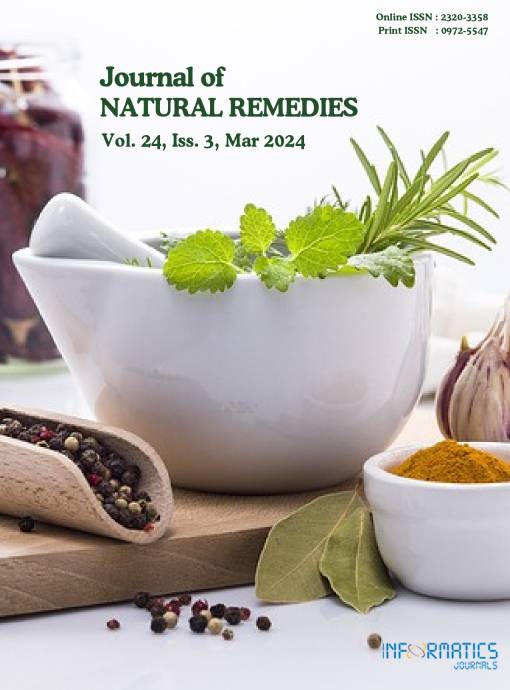Appropriate Timing of Medicine (Aushadhi Sevan Kal) Can Better Impact Patient Outcome — A Case Report of Acute Gastroenteritis (Atisara)
DOI:
https://doi.org/10.18311/jnr/2024/33604Keywords:
Atisara, Aushadh Sewan Kal, Circadian Rhythm, Gastroenteritis, Gut MicrobiomeAbstract
Aushadh sewan kal (ASK) is vital in managing the disease. ASK varies with various factors such as the disease’s strength, the patient’s strength, the predominance of Dosha (regulatory functional factors of the body), Dushya (which gets vitiated), etc. Precision in ASK is vital to achieve greater efficacy and a lesser quantity of medicine. Lack of this precision may produce unwanted effects. A 31-year-old female patient came to OPD of Kayachikitsa GAC, Nagpur, with complaints of loose motion (10 episodes), vomiting (4 episodes), nausea, abdominal pain, body aches, and general weakness since one day, headache, burning sensation in the stomach since morning. She was diagnosed with acute gastroenteritis (Atisara). Atisara treatment containing Musta, Takra, and Bilvavleh was used. After the modification of the same medicines in ASK, pain reduction and complete recovery were achieved. There was a significant decrease in subjective parameters after administering medicine in appropriate ASK. Significant improvements in Jaran Shakti score (Capacity to digest), Abhyawaran shakti score (capacity to eat), and Ruchi factor (appetite) were also noted. ASK is important in the administration of Aushadha (medicine). Negligence in ASK may decrease the efficacy of medications. This case report emphasises the relationship between Agni (metabolic power), gut microbiome, circadian rhythm, and ASK. This case report gives future direction for various studies to understand the interplay between Agni (metabolic energy), gut microbiome, circadian rhythm, ASK, and the effect of this interplay on patient outcome.
Downloads
Metrics
Downloads
Published
How to Cite
Issue
Section
License
Copyright (c) 2024 Amit Nakanekar, Punam N. Khobarkar (Author)

This work is licensed under a Creative Commons Attribution 4.0 International License.
Accepted 2024-01-05
Published 2024-03-27
References
Choi H, Rao MC, Chang EB. Gut microbiota as a transducer of dietary cues to regulate host circadian rhythms and metabolism. Nature Reviews Gastroenterology and Hepatology. 2021; 18(10):679-89. https://doi.org/10.1038/ s41575-021-00452-2 PMid:34002082 PMCid:PMC8521648
Gorkiewicz G, Moschen A. Gut microbiome: A new player in gastrointestinal disease. Virchows Arch. 2018; 472(1):159-72. https://doi.org/10.1007/s00428-017-2277-x PMid:29243124 PMCid:PMC5849673
Graves NS. Acute gastroenteritis. Prim Care. 2013; 40(3):727-41. https://doi.org/10.1016/j.pop.2013.05.006 PMid:23958366 PMCid:PMC7119329 4. Shastri A. Sushrut Samhita of Sushruta, 1st edition, Varanasi: Chaukhamba Sanskrit Sansthan, (Uttartantra 49/6); 2013. p. 73.
Garde G. Ashtang Hriday of Vagbhata, 1st edition, Varanasi: Chaukhamba Sanskrit Series, (Chikitsasthan 9 /1); 2019. p. 270.
Tripathi B. Charak samhita of Charaka, 1st edition, Varanasi: Chaukhamba Surbharati Prakashan, (Chikitsasthan 30/296.); 2013. p. 1059.
Tripathi B. Charaksamhita of Charaka, 1st edition, Varanasi: Chaukhamba Sanskrit series, (Vimansthan 8/28); 2013. p. 775.
Hawker GA, Mian S, Kendzerska T, French M. Measures of adult pain: Visual Analog Scale for pain (VAS Pain), Numeric Rating Scale for pain (NRS Pain), McGill Pain Questionnaire (MPQ), Short-Form McGill Pain Questionnaire (SF-MPQ), Chronic Pain Grade Scale (CPGS), Short Form-36 Bodily Pain Scale (SF-36 BPS), and measure of Intermittent and Constant Osteoarthritis Pain (ICOAP). Arthritis Care and Research. 2011; 63(Suppl 11):S240-52.
Patil VC, Baghel MS, Thakar AB. Assessment of agni (Digestive function) and koshtha (Bowel movement with special reference to Abhyantara snehana (Internal oleation). Ancient Science of Life. 2008; 28(2):26-8. https:// doi.org/10.1002/acr.20543 PMid:22588748
Tripathi B. Charaksamhita of Charaka, 1st edition, Varanasi: Chaukhamba Sanskrit series, (Chikitsasthan 19/23); 2013. p. 677.
Tripathi S. Dravyagun Vidhnyan Part 2, Chaukhamba Bharati Academy; 2011. p. 119, 120, 366, 367, 371, 372.
Tripathi B. Sharangdhar Samhita, 1st edition, Varanasi: Chaukhamba Sanskrit Seies, (Purvakhanda 4/11); 2013. p. 34.
Tripathi S. Dravyagun Vidhnyan Part 2, Chaukhamba Bharati Academy; 2011. p. 323, 324.
Shastri B. Bhavprakash Samhita, 12th edition, Varanasi: Chaukhamba Sanskrit Seies, (Purvakhanda 3-6, 15,16); 2018. p. 919, 920.
Garde G. Ashtang Hriday of Vagbhata, 1st edition, Varanasi: Chaukhamba Sanskrit Seies, (Chikitsasthan 9/8); 2019. p. 271. 16. Nobs SP, Tuganbaev T, Elinav E. Microbiome diurnal rhythmicity and its impact on host physiology and disease risk. EMBO Reports. 2019; 20(4). https://doi.org/10.15252/ embr.201847129 PMid:30877136 PMCid:PMC6446202 17. Lopez DEG, Lashinger LM, Weinstock GM, Bray MS. Circadian rhythms and the gut microbiome synchronize the host’s metabolic response to diet. Cell Metabolism. 2021; 33(5):873-87. https://doi.org/10.1016/j.cmet.2021.03.015 PMid:33789092 18. Curtis AM, Bellet MM, Sassone-Corsi P, O’Neill LA. Circadian clock proteins and immunity. Immunity. 2014; 40(2):178-86.
https://doi.org/10.1016/j.immuni.2014.02.002 PMid:24560196 19. Athawale P. Ashtang Sangrah, 2nd edition, Nagpur: Godavari Publishers, (Sutrasthan 23/14, 16); 2006. p. 190.
Garde G. Ashtang Hriday of Vagbhat, 1st edition, Varanasi: Chaukhamba Sanskrit Seies, (Sutrasthan12 /9); 2019. p. 55.
Tripathi B. Charak Samhita of charaka,1st edition, Varanasi Chaukhamba Surbharati Prakashan, (Chikitsasthan 30/299); 2013. p. 1059.
Shastri A. Sushrut Samhita of Sushruta, 1st edition, Varanasi: Chaukhamba Sanskrit Sansthan, (Uttartantra 64/71); 2013. p. 624.
Athawale P. Ashtang Sangrah, 2nd edition Nagpur: Godavari Publishers, (Sutrasthan 23/14); 2006. p. 190.
Athawale P. Ashtang Sangrah, 2nd edition, Nagpur: Godavari Publishers; (Sutrasthan 23/20); 2006. p. 191. 25. Athawale P. Ashtang Sangrah, 2nd edition, Nagpur: Godavari Publishers, (Sutrasthan, 23/16); 2006. p. 191.
Nakanekar, A, Thote P, Palan N, Deshmukh P, Gulhane J, Salunke A. A case report on Ayurvedic management of acute renal colic. Ancient Science of Life. 2018; 37(3):162-7. https://doi.org/10.4103/asl.ASL_7_18
Junjarwad AV, Savalgi PB, Vyas MK. Critical review on Bhaishajya Kaala (time of drug administration) in Ayurveda. Ayu. 2013; 34(1):6-10. https://doi.org/10.4103/0974- 8520.115436 PMid:24049398 PMCid:PMC3764882

 Amit Nakanekar
Amit Nakanekar









 0.35
0.35 24
24 0.161
0.161